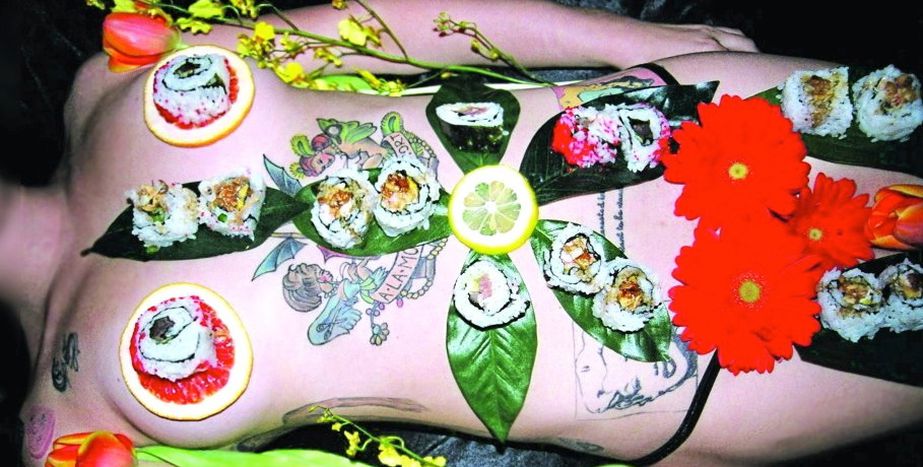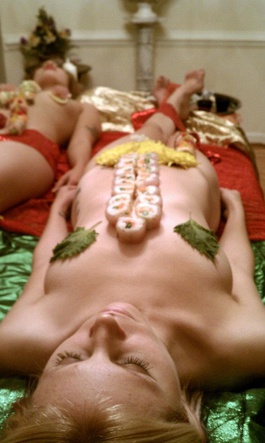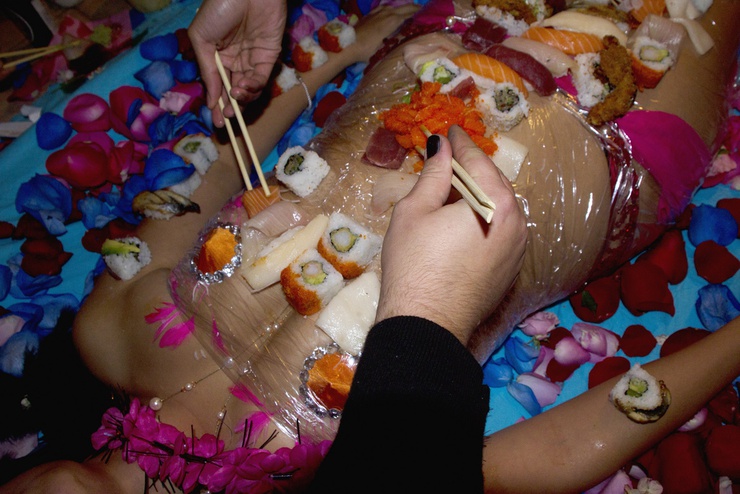
‘Body sushi’ at Japanese restaurant in Rome
Published on
Italian equality activists call it is no country for women. Geography teacher Maria Pia Ercolini proposes the introduction of streets named after women, the writer Anais Ginori wrote a book on the objectification of the female body and Lorella Zanardo analysed the negative image of women in the media for a famous documentary.
So what of these feasts eaten directly off naked female bodies in the Italian capital?
‘Serving a meal from a human body ennobles the food. It becomes a ‘living dish’,’ says Angela, who runs a Japanese restaurant which opened in November 2008 in Rome, not far from the city centre. The visuals in the menu do not bring a good meal immediately to mind, but rather a corpse being prepared for a funeral. Nyotaimori, often referred to as ‘body sushi’, means ‘presenting a meal on a woman’s body’ in Japanese, with the service available since 2011. It is not a simple procedure, explains Angela. ‘The model is not supposed to eat for six hours before the show in order to minimise her biological needs as she is serving sushi,’ explains Angela.
 Born in Hong Kong and raised in Italy, the representative of the restaurant who I meet seems to have a thorough grasp of the novelties of the Japanese culture. ‘We check her ability to remain still by placing six eggs on her body,' she says. 'The process of decorating and preparing the model with the food lasts for three hours.' I wonder if it is easy to find a suitable model may be difficult; being a ‘live platter’ is surely a role which does not have much in common with modelling? Francesco, a Yoshi restaurant employee, assures that there is no problem with finding a ‘suitable girl. They usually are eager to work with us since all they have to do is lie down on their backs for a couple of hours and then get paid for that.’ Some highlight the injurious aspect of this practice. ‘It is humiliating for a woman to be treated like an object, when she is completely undressed and forbidden to speak,’ says Chiara, an art student at the university of Florence. Yet playing the role of a live platter is the result of a free-will decision of the model who is recruited via legitimate job agencies.
Born in Hong Kong and raised in Italy, the representative of the restaurant who I meet seems to have a thorough grasp of the novelties of the Japanese culture. ‘We check her ability to remain still by placing six eggs on her body,' she says. 'The process of decorating and preparing the model with the food lasts for three hours.' I wonder if it is easy to find a suitable model may be difficult; being a ‘live platter’ is surely a role which does not have much in common with modelling? Francesco, a Yoshi restaurant employee, assures that there is no problem with finding a ‘suitable girl. They usually are eager to work with us since all they have to do is lie down on their backs for a couple of hours and then get paid for that.’ Some highlight the injurious aspect of this practice. ‘It is humiliating for a woman to be treated like an object, when she is completely undressed and forbidden to speak,’ says Chiara, an art student at the university of Florence. Yet playing the role of a live platter is the result of a free-will decision of the model who is recruited via legitimate job agencies.
Dinner on a Japanese more delicious than on an Italian
The interior design of Yoshi restaurant is marked by European features. The patterned upholstery of the chairs and the floor cushions have nothing to do with Japanese minimalism. Chopsticks for eating sushi are placed on the table, though my poor wallet means I am not privy to the show tonight. It costs 200 euros for the model’s service, and 60 euros per diner. The ‘art’ of nyotaimori is increasingly popular in European countries, although not many establishments offer it on a regular basis. In Rome, Yoshi is one of three restaurants offering ‘body sushi’. The practice is not only limited to using a woman’s body; its male counterpart is Nantaimori, although the demand for it is much lower. ‘Women rarely order a body sushi dinner. Even if they decide to do so, they often call it off at the last moment,’ says Francesco. ‘I guess they are embarrassed.’

Whereas for the Japanese the country of origin of the model is of a minor importance, for the Italians it is a fundamental feature. The Italians prefer Japanese models, says Francesco. This may imply that for a Japanese person the ritual itself is important, while an Italian would rather make sure that Nyotaimori remains an authentic experience, ‘just like in Japan’. It must be spectacular and exotic enough to suit the occasion, as it is usually ordered for bachelor and bachelorette parties. ‘90% of the customers ordering a body sushi dinner are Italian - the rest are foreigners,’ says Luigi, manager of the Gestalt Eventi company, which also offers body sushi services in limousines. As for the Japanese, ‘They do not really visit our restaurant,’ to put it in Francesco’s words. The majority of random Romans I meet are not so enthusiastic about the practice. ‘An ordinary dinner at a restaurant is enough for me,’ says Marco, a psychology student at Rome’s Sapienza university. ‘You always see practically naked dancers in night clubs. At home we usually dine dressed, but in private situations I guess this kind of body sushi is…why not!’
Art vs. objectification
This kind of exotic performance may be risky in a society devoted to traditional values, and where feminist organisations radically object to the discrimination of women. The restaurant owners see it differently, assuring me that their customers order body sushi for its spectacular aesthetic form and the opportunity to contemplate the art. After all, Galileo, Michaelangelo, Bernini, Rafael, Peruzzi and Fontana took care of the original aesthetic side of Rome. Apparently people still can’t get their fill of natural beauty... Are the restaurant’s customers really coming to feast off a naked body for the same reasons that would visit an art gallery or a museum – to satisfy their hunger for the post-renaissance aesthetic? ‘This tradition is spiritually enriching,’ says Francesco. ‘It makes the woman become a work of art.’ This is precisely how she is supposed to act; what kind of human reflex is allowed for her? ‘For example if the model is feeling sleepy, she may chat with the guests.’

Those are the three reasons given to me for body sushi: art, entertainment and the ‘spiritual’ nature of it; at a push, to get to know Japanese culture. However in September 2012, the Japanese embassy in Rome presumably caught wind of this, prompting the released of an official statement denying that Nyotaimori constituted a part of Japan’s culinary culture: 'There is no relationship between nyotaimori and Japanese culinary culture or habits. From the perspective of the ordinary Japanese, it falls outside the realm of common sense.' They reiterate the 'ridiculous' matter over the phone: ‘Body sushi has no connection with the Japanese culture,’ they reiterate over the phone. Data confidentiality means that I cannot access the body sushi models themselves, giving rise to my view that concerns seen from the perspective of the human table must reveal that it is not artistic, spiritual and reputable enough for them.
This article is part of the final edition of cafebabel.com’s flagship project of 2012, the sequel to ‘Orient Express Reporter’, sending Balkan journalists and photographers to EU cities and vice versa for a mutual pendulum of insight. Many thanks to the folks at cafebabel.com Rome, especially Ottavio and Tiziana
The images in this article are not related to Yoshi restaurant. Main (cc) The Nyotaimori Experience on facebook ; in-text (cc) Nyotaimori Italia; (cc) alexandrakgallery/ flickr
Translated from ''Nagie sushi wzbogaca duchowo''



